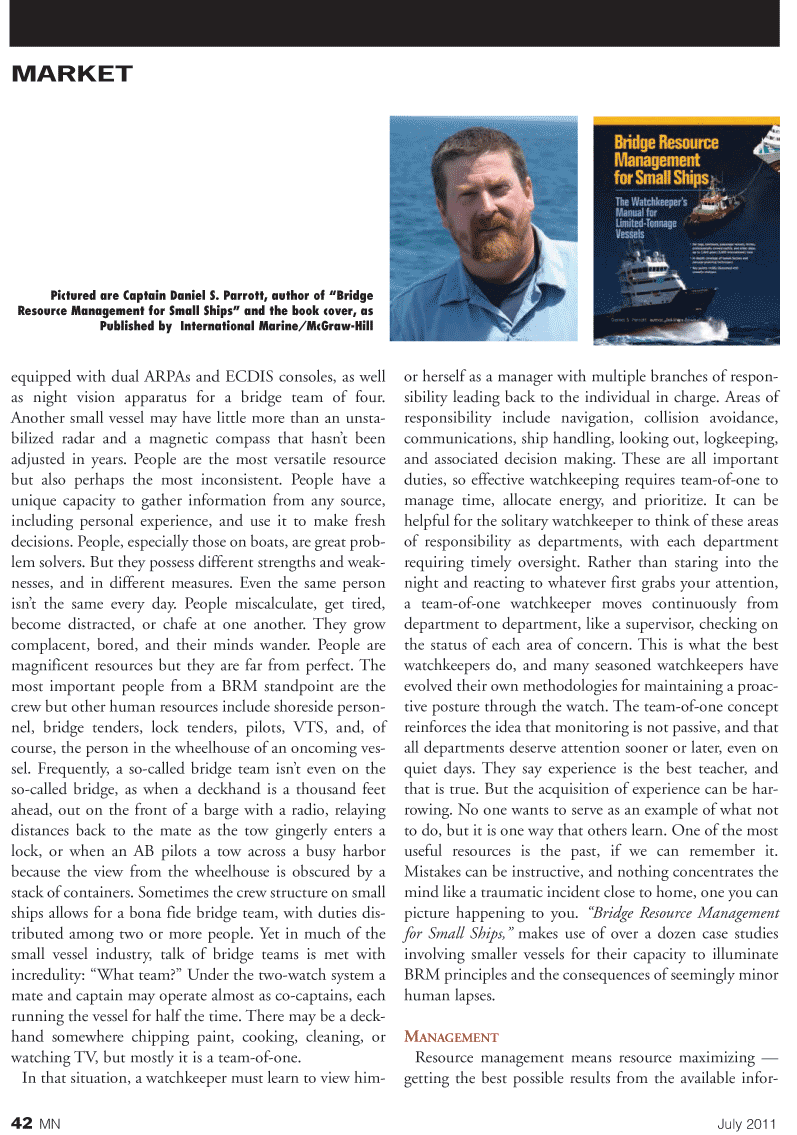
Page 42: of Marine News Magazine (July 2011)
Workboat Power
Read this page in Pdf, Flash or Html5 edition of July 2011 Marine News Magazine
42MNJuly 2011equipped with dual ARPAs and ECDIS consoles, as well as night vision apparatus for a bridge team of four. Another small vessel may have little more than an unsta- bilized radar and a magnetic compass that hasnt been adjusted in years. People are the most versatile resource but also perhaps the most inconsistent. People have a unique capacity to gather information from any source, including personal experience, and use it to make fresh decisions. People, especially those on boats, are great prob- lem solvers. But they possess different strengths and weak- nesses, and in different measures. Even the same person isnt the same every day. People miscalculate, get tired, become distracted, or chafe at one another. They grow complacent, bored, and their minds wander. People are magnificent resources but they are far from perfect. The most important people from a BRM standpoint are the crew but other human resources include shoreside person- nel, bridge tenders, lock tenders, pilots, VTS, and, of course, the person in the wheelhouse of an oncoming ves- sel. Frequently, a so-called bridge team isnt even on the so-called bridge, as when a deckhand is a thousand feetahead, out on the front of a barge with a radio, relaying distances back to the mate as the tow gingerly enters a lock, or when an AB pilots a tow across a busy harbor because the view from the wheelhouse is obscured by a stack of containers. Sometimes the crew structure on small ships allows for a bona fide bridge team, with duties dis- tributed among two or more people. Yet in much of the small vessel industry, talk of bridge teams is met with incredulity: What team?? Under the two-watch system a mate and captain may operate almost as co-captains, eachrunning the vessel for half the time. There may be a deck- hand somewhere chipping paint, cooking, cleaning, or watching TV, but mostly it is a team-of-one. In that situation, a watchkeeper must learn to view him- or herself as a manager with multiple branches of respon- sibility leading back to the individual in charge. Areas of responsibility include navigation, collision avoidance, communications, ship handling, looking out, logkeeping,and associated decision making. These are all important duties, so effective watchkeeping requires team-of-one to manage time, allocate energy, and prioritize. It can be helpful for the solitary watchkeeper to think of these areas of responsibility as departments, with each department requiring timely oversight. Rather than staring into the night and reacting to whatever first grabs your attention, a team-of-one watchkeeper moves continuously from department to department, like a supervisor, checking on the status of each area of concern. This is what the best watchkeepers do, and many seasoned watchkeepers have evolved their own methodologies for maintaining a proac- tive posture through the watch. The team-of-one concept reinforces the idea that monitoring is not passive, and that all departments deserve attention sooner or later, even on quiet days. They say experience is the best teacher, and that is true. But the acquisition of experience can be har- rowing. No one wants to serve as an example of what not to do, but it is one way that others learn. One of the most useful resources is the past, if we can remember it. Mistakes can be instructive, and nothing concentrates the mind like a traumatic incident close to home, one you can picture happening to you. Bridge Resource Management for Small Ships,? makes use of over a dozen case studies involving smaller vessels for their capacity to illuminate BRM principles and the consequences of seemingly minorhuman lapses.MANAGEMENT Resource management means resource maximizing ? getting the best possible results from the available infor- MARKETPictured are Captain Daniel S. Parrott, author of BridgeResource Management for Small Ships? and the book cover, asPublished by International Marine/McGraw-Hill

 41
41

 43
43
